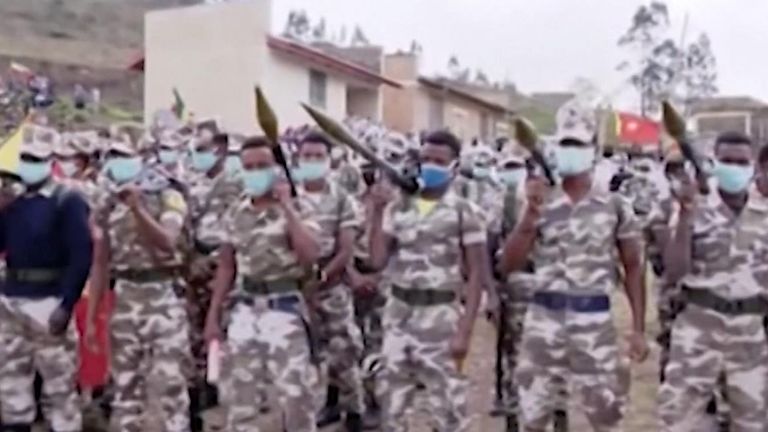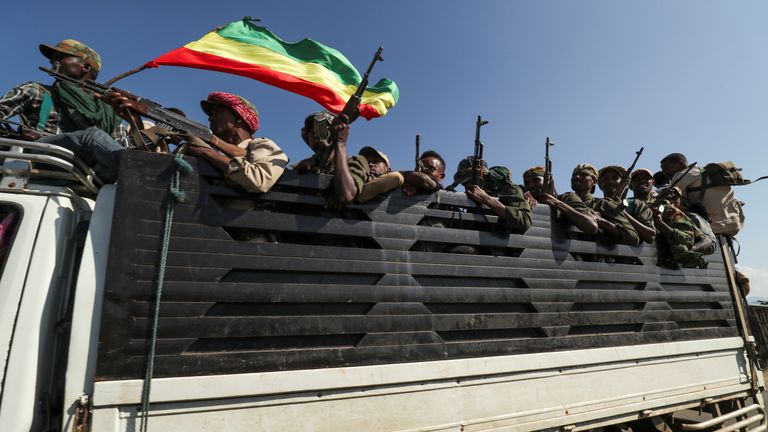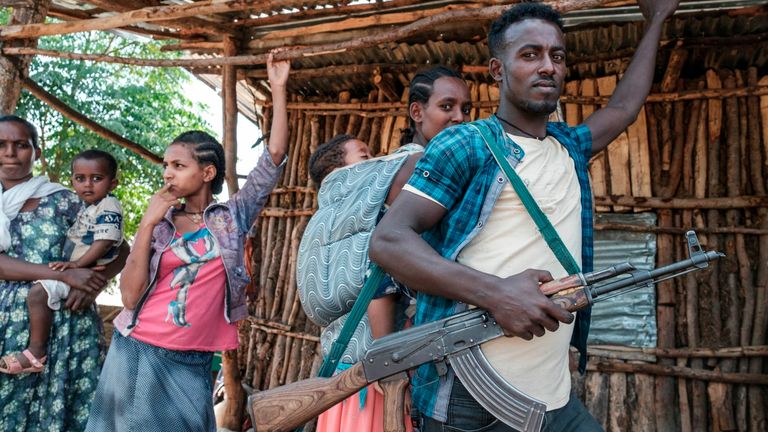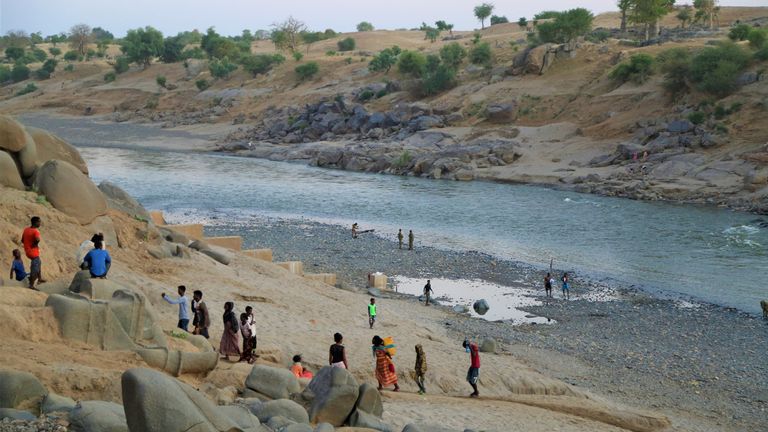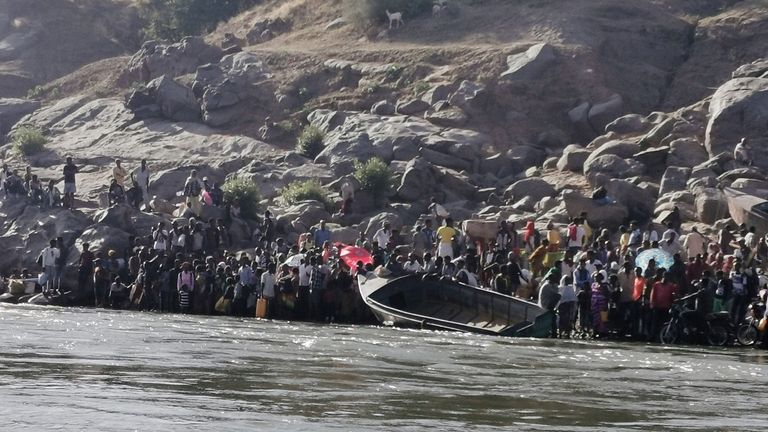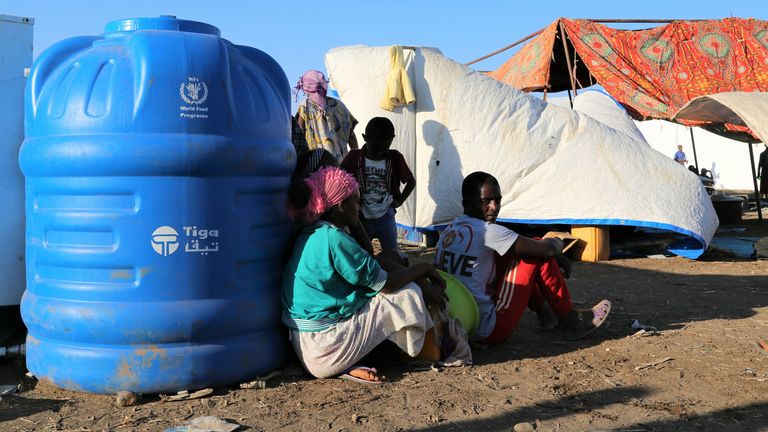Ethiopia is facing a civil war between government forces and troops in its northern Tigray region which has caused tens of thousands to flee.
The conflict erupted in early November, just a year after Ethiopian Prime Minister Aiby Ahmed received the Nobel Peace Prize for resolving the 20-year border conflict with Eritrea.
Sky News looks at how the violence started, why it did and what effect it is having on Ethiopia‘s people.
What is happening in Ethiopia?
On 4 November, the prime minister sent troops to a military base in the northern region of Tigray, which borders Eritrea and Sudan.
He accused the region’s ruling party, the Tigray People Liberation Front (TPLF), of attacking the base and announced in a televised broadcast days later the Ethiopian military had bombed the base in retaliation.
A few days after that, Amnesty International reported hundreds of people may have been killed in an attack with knives and machetes in the Tigrayan town of Mai Kadra.
The TPLF was blamed but its leadership has denied responsibility.
“We have confirmed the massacre of a very large number of civilians, who appear to have been day labourers in no way involved in the ongoing military offensive,” Deprose Muchena, Amnesty’s east and southern Africa director, said in a statement.
Communication in the region was cut off in early November so reports have often been delayed and people are unable to contact their families.
On 13 November, Tigray launched rockets at two airports in neighbouring Amhara province and the next day said it had fired rockets at targets in neighbouring Eritrea.
Tigray’s regional president, Debretsion Gebremichael, claimed Eritrea sent troops and tanks into Tigray to support the Ethiopian government.
He told Reuters the rockets were retaliation, but he did not provide any evidence to back up the allegations.
Tigray has a paramilitary force and a local militia of about 250,000, according to the International Crisis Group.
Why is the conflict happening now?
Before populist Mr Abiy was elected in 2018 off the back of anti-government protests, Ethiopia was ruled by the TPLF as part of a coalition after overthrowing the former dictatorship in 1991.
The current government says it has worked hard to include members of the former ruling coalition and previously excluded ethnic groups – but this has not included the TPLF.
Tigray has openly resisted Mr Abiy’s call to unify the country by increasing the central government’s power, as have other regions and ethnic groups.
The TPLF viewed the ruling coalition as illegal and after Mr Abiy cancelled elections due to COVID-19, they set up their own election board to oversee regional elections in September.
Mr Abiy said he does not recognise the results of those elections and banned foreign journalists from travelling to Tigray to document the election.
The government in Addis Ababa voted to cut funds to the TPLF in October, which further enraged its leaders.
How has this affected civilians?
Tens of thousands of Ethiopians have fled Tigray into Sudan since early November, with the United Nations (UN) predicting 200,000 will have fled within six months.
The UN said 6,000 refugees are entering Sudan every day, with more than 31,000 having crossed over by 20 November.
Tigray was already home to as many as 200,000 refugees and displaced people, UN agencies said.
Aid groups have said they have been prevented from helping in Tigray and journalists are also not allowed in to report on what is happening.
NGOs have asked the Ethiopian government to secure access for them to Tigray so they can provide supplies to civilians stranded by the fighting.
Mr Abiy said on 16 November his government is “ready to receive and reintegrate our fellow Ethiopians fleeing to neighbouring countries”.
But, thousands keep fleeing and many have horror stories of seeing their friends and family killed, while others do not know where their family is as communication was cut off in Tigray.
Sudan’s Um Raquba camp has reopened to house refugees 20 years after closing, after hosting thousands of Ethiopians during the country’s worst famine of the 20th century from 1983 to 1985.
The UN called for an immediate ceasefire on 20 November so humanitarian corridors could be established to allow civilians to flee safely.
What does the conflict mean for the wider region?
It risks destabilising the region and could lead to the mass displacement of Africa’s second most populous country, with 110 million people.
A close military ally of the United States, Ethiopia was seen as an essential element in maintaining peace in the fragile Horn of Africa.
But this could be shattered by the war spilling into Eritrea, and by the fact about 96,000 Eritrean refugees living in Tigray could be displaced again.
With Ethiopian refugees fleeing into Sudan, which already had 1.1 million refugees, this risks destabilising the fragile transition it is going through, alongside the economic crisis it is already in.
Ethiopia also runs a successful peacekeeping mission in neighbouring Somalia, but that is now under threat because of its inner turmoil.

